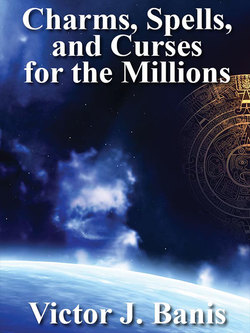Читать книгу Charms, Spells, and Curses - V. J. Banis - Страница 5
На сайте Литреса книга снята с продажи.
ОглавлениеINTRODUCTION
In this country and time, magic is very much in disrepute. Bring the subject up at a dinner gathering, and most of those present, if not all, will wrinkle their noses in amusement and openly pooh-pooh the matter. But what is truly amusing is that these same skeptics remain unaware of how strong and ingrained is their belief in the supernatural and how often they appeal to it.
“Of course I don’t believe in magic. Oh, good luck on your trip.” “There’s no such thing; I make my own luck, and I plan to continue doing so, knock on wood.” “People are finally coming to realize how silly all this supernatural nonsense is, Lord willing.” Such conversational paradoxes would be funny if they weren’t so common and so unconscious.
The truth is, we all believe in magic to some extent and try to influence natural events by its use, whether we cross our fingers, knock on wood, avoid black cats, hesitate to walk under ladders, blow out a match before the third cigarette is lit, toss spilled salt over our left shoulders, wish one another luck, wear good luck charms, carry rabbit’s feet, finger rosaries, pray, become nervous on Friday the thirteenth, or perform any of hundreds of symbolic gestures that have carried down to us from generations of believers.
If we are reluctantly persuaded to admit that we do use certain magic charms and conjurations, we are often downright horrified that anyone should think we actually believe in them, or expect them to work, or give any credence to witches.
Here again, we make liars and fools of ourselves. It would be sheer nonsense to say that witches haven’t existed and don’t exist right now. And they use magic, in many instances the same sort of magic we all utilize. And the simple truth is, it works—at least, some of the time.
In some instances, there is absolutely nothing surprising about this success. Any man of science who examines the history of witchcraft, for instance, will discover that witches have always concentrated a great deal of their attention on healing physical ailments, frequently by the use of herbs. And a little examination will prove that some of their cures had every reason to work. Often the witches of the Middle Ages were expert herbalists, using healing techniques that have since become commonplace. It was once thought clever to laugh at the witches of England who used a type of mold to heal various ailments—until we discovered the healing powers of penicillin, which is produced from mold. Witch doctors amused Britishers with their use of a certain drug to heal “illnesses of the soul,” until someone investigated this strange drug and found the parent of the modern-day tranquilizer. Witches recommended frog’s eggs as a sort of disinfectant; today we know that they have a high iodine content. Many witch recipes called for plantain leaves or roots. The late W. H. Box, a world-famous authority on herbalism, has said that plantain could cure almost anything, from poisoning to piles.
The power of suggestion was no doubt a powerful factor working in the witch’s favor, especially through the centuries in which people’s faith was strong—faith in God, in Satan, and in hosts of other forces.
As to whether there was something more involved than fundamental scientific luck and the power of suggestion—well, nothing will be accomplished by reopening that quarrel. Our purpose here has been to bring together a collection of specific charms, curses, and spells in a sort of “recipe book” or “how-to.” There are plenty of other volumes on the subjects of witchcraft and magic, but all too often they deal in vague generalities or mumbo jumbo and tell us about this or the other spell but never get around to telling us the spell itself. We have avoided that here, within certain limitations—obviously some of the ingredients may sound strange to the modern reader. If we were to try to provide encyclopedic information on every item mentioned, we would probably get through no more than half a dozen spells. We have, for instance, included certain spells from the Egyptian magical writings. But we could have devoted at least one volume, more probably several, to trying to explain the hierarchy of Egyptian gods and goddesses, the fine points of their beliefs, and other relevant facts. We have chosen instead to present the spells and charms themselves, as often as possible in their original forms or in the simplest translations. They come from a variety of sources—English, Scotch, Egyptian, Chaldean, Babylonian, American, French, Greek, Roman. Some are as old as man himself. Others are apparently modern. Some have the ring of fine verse; others have only the clumsiest literary style.
Likewise, while we have tried to categorize the spells for the reader’s convenience, these categories have necessarily proven arbitrary time and again, and if a spell does not appear in the chapter in which it seems to belong, please read on; it may yet appear in some other section to which it seemed to us better suited.
A word of caution—no claims are made for the efficacy of any of these writings. They are presented as found and are offered as a matter of interest to students of the occult. If the novice should wish to try them and they should produce results, well, that is his good fortune. If they do not—well, we can only cross our fingers and try again.
